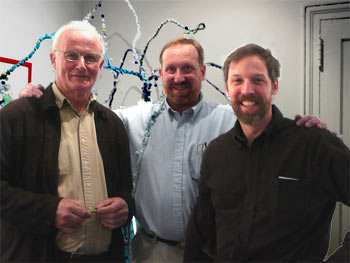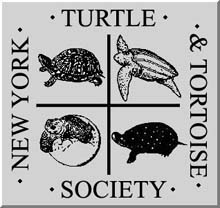  The New York Turtle and
The New York Turtle and
Tortoise Society presents

Seminar 2010

Saturday, April 17, 2010

The Arsenal, Central Park
5th Avenue at 64th Street
New York City
Seminar 2010, the twenty-fifth NYTTS Annual Seminar, was held in the Arsenal Gallery, 3rd Floor, Arsenal Building, Central Park, New York City. |
 |
|
|

Seminar speakers: Peter Pritchard, Hal Avery, and Peter Taylor

Photo: Anita Salzberg |
|
 Scheduled Program
Scheduled Program
 Morning Session
Morning Session
 |
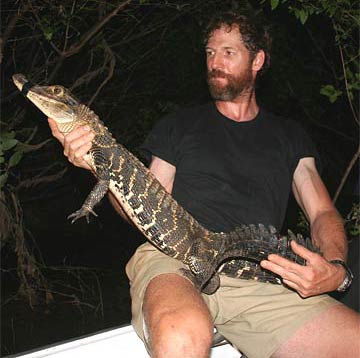

Peter Taylor with #6 of 600 black caiman now marked in the Rupununi, Guyana study. Photo: Ashley Holland
| |
 |
Peter Taylor
Project Coordinator, Rupununi Learners
Incorporated Black Caiman Project, Guyana

“Black Caiman in Guyana: An Amerindian Community Manages its Natural Resources”
This talk will focus not only on what has been learned about the ecology of the largest vertebrate animal on the continent, the black caiman (Melanosuchus niger), but also about how native Macushi have learned to live with such an intimidating predator in their midst. In the Rupununi region of Guyana an Amerindian community is now participating in a major field study of the animal, and they are using ecotourism to support it. In the course of this presentation you will meet the three other species of caiman that live there too, along with an astounding range of bizarre creatures in this, as yet, scarcely disturbed land.

Basic goals of the study are:

- Conduct a detailed ecological study of the black caiman (Melanosuchus niger) and track its status.
- Train indigenous Macushi in field techniques and data collection.
- Define problems in order to develop management protocols related to HCCs (Human Crocodile Conflicts) as defined by the IUCN Crocodile Specialist Group.
- Provide informed recommendations for the sustainable use of black caiman.
 |
 |
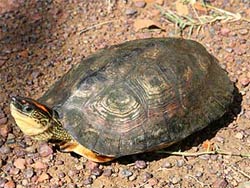

Spot-legged wood turtle (Rhinoclemys punctularia) captured near Katoka Village, Region #9, Guyana. Photo: Peter Taylor
|
|
In addition to the main focus on crocodilians, a range of other local wildlife and herpetofauna, including turtles and tortoises, will be discussed.

Peter Taylor considers himself one among a legion of herp enthusiasts with a life long interest in the subject. However, his fascination and concern with nature is hardly confined to the cold-blooded fraternity. Many animal-related jobs and experience gained in private collections preceded his securing a Reptile Keeper position at the Bronx Zoo. Nine years later he took a Zoological Manager position in the St. Louis Zoo Herpetology Department. During that time an M.S. in tropical ecology was completed at the University of Missouri, St. Louis. Wide-ranging U.S. travel; fieldwork in Venezuela, Guyana, and St. Lucia; and visits to South Africa and Australia inspired the formation of the Black Caiman Project and study of herpetofauna in Guyana, the main subject of today’s talk.

If there is one thing that can keep Peter out of the field, it’s working in zoos or visiting them. So far he’s enjoyed about 170 public zoos and private collections in 15 countries.

Afternoon Session

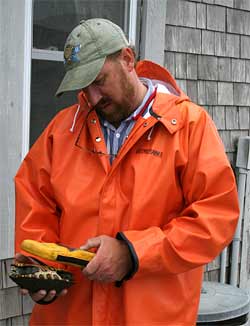

Hal Avery scanning a diamondback terrapin for a pit tag
|
 Hal Avery
Hal Avery
Associate Professor, Department of Biology, Drexel University,
Philadelphia, Pennsylvania

“Anthropogenic Effects on the Population Biology
of the Desert Tortoise and the Diamondback Terrapin
in the United States”

Population models of turtles show that elevated rates of mortality in adults cause the greatest rates of long-term population decline compared with increases in mortality of juveniles, hatchlings, or eggs. However, these models ignore the greater impact of elevated adult female mortality versus elevated adult male mortality. Because female turtles generally take much longer to mature and expend greater proportions of their stored energy, water, and nutrients for reproduction compared with males, anthropogenic factors that cause high mortalities in adult female turtles will have the greatest impact on population declines of turtles.

Although they live in very different ecosystems, the desert tortoise (Gopherus agassizii) and the diamondback terrapin (Malaclemys terrapin) have remarkably similar patterns of decline in relation to human impacts. Population studies over the last 20 years of the desert tortoise in the Mojave Desert of California and the diamondback terrapin in Barnegat Bay Estuary of New Jersey have shown that anthropogenic factors specific to each ecosystem cause disproportionately higher mortality rates in adult females than for adult males or juveniles within a population.

In desert ecosystems, adult female tortoises are more vulnerable than males to desiccation and starvation following drought because of their prior investment in reproduction. Livestock grazing exasperates this high adult female mortality by removing preferred plants and collapsing burrows in already physiologically stressful times.

 |
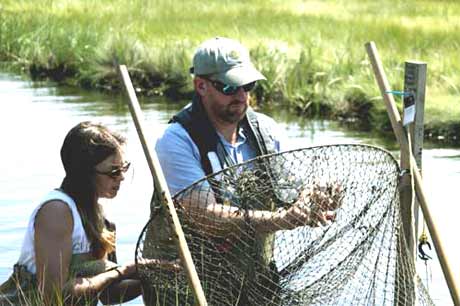

Graduate student Rachel Rutherford and Professor Hal Avery retrieve a terrapin from a trap in Barnegat Bay, New Jersey.
|
|
 |
In Mid-Atlantic estuaries, injuries and deaths caused by boats and motor vehicles impact adult female terrapins greater than adult males or any other size class. This is due to their greater home ranges, long excursions across open water, and nesting in upland areas fragmented by roads.

Reducing the human impacts that specifically cause higher adult female mortality is essential to conserving and recovering wild populations of tortoises and terrapins, which is undoubtedly also the case with many other chelonian species.

Hal Avery was one of the co-organizers of the NYTTS-sponsored International Tortoise and Turtle Conference held in Purchase, New York in 1993. He was a speaker and session chair at the conference, and a senior author in the Proceedings volume published by NYTTS.

An Associate Professor of Biology at Drexel University, Hal teaches Herpetology and has had over a dozen Ph.D. students studying turtles for their degrees. He has studied freshwater turtles, desert tortoises, and sea turtles for over 25 years throughout the USA as well as Costa Rica. As a Biologist for the U.S. Department of the Interior for ten years, he studied the nutrition, population ecology, and conservation of the desert tortoise in the Mojave Desert of California.

Current field research includes studies on the population ecology and conservation biology of diamondback terrapins in New Jersey, and on the invasion of red-eared sliders and effects on native red-bellied turtles and other freshwater turtles in Pennsylvania. He also works with Drexel graduate students on black turtles, leatherbacks, and olive ridleys in Costa Rica, and on loggerheads in Greece. Links to his current work include his research program at Drexel University, the Earthwatch Diamondback Terrapins of Barnegat Bay, and a Newsweek video, Conservation in an Unlikely Place.

 |
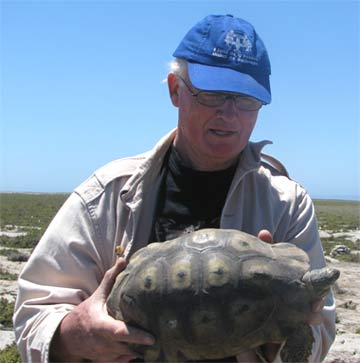

Peter Pritchard holds record-size
Bowsprit tortoise, Chersina angulata. |
|
 |
Peter C. H. Pritchard
Director, Chelonian Research Institute, Oviedo, Florida

“A Visit to South Africa,
the World Headquarters of Tortoise Diversity”

In North America, there is never more than one tortoise species in a given area; indeed the four species are hundreds of miles apart. South America is almost as bad, but with some degree of sympatry between the yellowfoot and the redfoot tortoises. In Europe, there is very little overlap between the marginated, Greek, and Hermann’s tortoises.

On the other hand, the pace picks up a bit in Africa, with one of the smallest tortoises (Testudo kleinmanni) inhabiting the northern fringes of the Sahara, and the largest continental tortoise (sulcata) occupying arid habitats in the southern Sahara. But South Africa has the greatest diversity of all, with several genera (Chersina, Homopus, Kinixys, Psammobates, Geochelone, etc.) and the greatest diversity of sympatric tortoise species anywhere on Planet Earth. This is made ecologically possible by tortoises of drastically different adult size having different niches, diets, predators, and altitude. Sympatry is the greatest in the Great Karoo National Park where all the five resident species avoid damaging competition, in part,
 |
 |
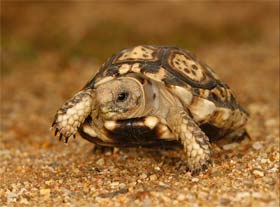

Speckled Padloper (Homopus signatus) of South Africa is the smallest living tortoise.
Photo: AndreC, www.outdoorphoto.co.za
|
|
by having different types of hot weather retreat (rock crevices versus vegetation), and in part by all being in very low density, so that resource sharing is possible.

Peter Pritchard, one of the world’s foremost experts on turtles and tortoises, is well known to NYTTS members. He is the Director of the Chelonian Research Institute in Oviedo, Florida, which houses one of the largest collections of turtle specimens in the world. He received his Bachelor’s degree from Oxford and his Ph.D. from the University of Florida, where he studied marine turtles with Archie Carr as his major professor. Peter has written eight books about turtles, the most recent a semi-autobiographical work entitled Tales from the Thébaïde. He has studied turtles in many parts of the world, and for several decades has operated a field station in Guyana for protection of nesting marine turtles. Currently, his main activities involve turtles and tortoises in the Galápagos Islands and in eastern Asia, as well as performing a variety of roles in the administration and operation of the Chelonian Research Institute.

|
|
 |
|


